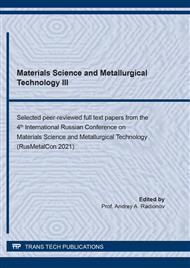[1]
K. Tsesmelis, Bauxite mine rehabilitation and bauxite residue management: A global perspective, in: Proceedings of 35th International ICSOBA Conference, Hamburg, Germany, 2017, pp.71-72.
Google Scholar
[2]
I.V. Loginova, A.A. Shoppert, L.I. Chaikin, Effect of adding sintering furnace electrostatic precipitator dust on combined leaching of bauxites and cakes, Metallurgist. 59 (2015) 698-704.
DOI: 10.1007/s11015-015-0161-y
Google Scholar
[3]
L. Chaikin, A. Shoppert, D. Valeev, I.V. Loginova and J.A. Napol'skikh, Concentration of rare earth elements (Sc, Y, La, Ce, Nd, Sm) in bauxite residue (red mud) obtained by water and alkali leaching of bauxite sintering dust, Minerals. 10(6) (2020) 500.
DOI: 10.3390/min10060500
Google Scholar
[4]
A. A. Shoppert, I.V. Loginova, J.A. Napol'skikh, Obtaining of pigment-quality magnetite from sintering process red mud, IOP Conf. Ser.: Mater. Sci. Eng. 969 (2020) 012056.
DOI: 10.1088/1757-899x/969/1/012056
Google Scholar
[5]
P. Davris, E. Balomenos, D. Panias and I. Paspaliaris, Selective leaching of rare earth elements from bauxite residue (red mud), using a functionalized hydrophobic ionic liquid, Hydrometallurgy. 164 (2016) 125-135.
DOI: 10.1016/j.hydromet.2016.06.012
Google Scholar
[6]
S. Reid, J. Tam, M. Yang and G. Azimi, Technospheric mining of rare earth elements from bauxite residue (red mud): process optimization, kinetic investigation, and microwave pretreatment, Sci. Rep. 7 (2017) 15252.
DOI: 10.1038/s41598-017-15457-8
Google Scholar
[7]
Y. Qu, B. Lian, Bioleaching of rare earth and radioactive elements from red mud using Penicillium tricolor RM-10, Biores. Technol. 136 (2016) 16-23.
DOI: 10.1016/j.biortech.2013.03.070
Google Scholar
[8]
Abhilash, S. Sinha, M.K. Sinha and B.D. Pandey, Extraction of lanthanum and cerium from Indian red mud, Int. J. Miner. Process. 127 (2014) 70-73.
DOI: 10.1016/j.minpro.2014.06.002
Google Scholar
[9]
E. Balomenos, P. Davris, Y. Pontikes and D. Panias, Mud2Metal: Lessons learned on the path for complete utilization of bauxite residue through industrial symbiosis, J. Sustain. Metall. 3 (2017) 551-560.
DOI: 10.1007/s40831-016-0110-4
Google Scholar
[10]
K. Binnemans, P.T. Jones, B. Blanpain, T. Van Gerven and Y. Pontikes, Towards zero-waste valorisation of rare-earth-containing industrial process residues: a critical review, J. Clean. Prod. 99 (2015) 17-38.
DOI: 10.1016/j.jclepro.2015.02.089
Google Scholar
[11]
C.R. Borra, B. Blanpain, Y. Pontikes, K. Binnemans and T. Van Gerven, Recovery of rare earths and other valuable metals from bauxite residue (red mud): a review, J. Sustain. Metall. 2 (2016) 365-386.
DOI: 10.1007/s40831-016-0068-2
Google Scholar
[12]
A. B. Botelho Junior, R. H. Costa, D.C.R. Espinosa and J.A.S. Tenório, Recovery of scandium by leaching process from brazilian red mud, Rare Metal Technology. 1 (2019) 73-79.
DOI: 10.1007/978-3-030-05740-4_8
Google Scholar
[13]
C.R. Borra, Y. Pontikes, K. Binnemans and T. Van Gerven, Leaching of rare earths from bauxite residue (red mud), Miner. Eng. 76 (2015) 20-27.
DOI: 10.1016/j.mineng.2015.01.005
Google Scholar
[14]
Z. Wang, X. Lin, Y. Tang, N. Kang, X. Gao, S. Shi and W. Huang, Laser-based directed energy deposition of novel Sc/Zr-modified Al-Mg alloys: columnar-to-equiaxed transition and aging hardening behavior, J. Mater. Sci. Technol. 69 (2021) 168-179.
DOI: 10.1016/j.jmst.2020.08.003
Google Scholar
[15]
Y. Zhang, H. Zhao, M. Sun, Y. Zhang, X. Meng, L. Zhang, X. Lv, S. Davaasambuu and G. Qiu, Scandium extraction from silicates by hydrometallurgical process at normal pressure and temperature, J. Mater. Res. Technol. 9 (2020) 709-717.
DOI: 10.1016/j.jmrt.2019.11.012
Google Scholar
[16]
S.-C. Li, S.-C. Kim and C.-S. Kang, Recovery of scandium from KOH sub-molten salt leaching cake of fergusonite, Miner. Eng. 137 (2019) 200-206.
DOI: 10.1016/j.mineng.2018.11.052
Google Scholar
[17]
S. Das, S. S. Behera, B. M. Murmu, R. K. Mohapatra, D. Mandal, R. Samantray, P. K. Parhi and G. Senanayake, Extraction of scandium(III) from acidic solutions using organo-phosphoric acid reagents: a comparative study, Sep. Purif. Technol. 202 (2018) 248-258.
DOI: 10.1016/j.seppur.2018.03.023
Google Scholar
[18]
W. Zhang, S. Yu, S. Zhang, J. Zhou, S. Ning, X. Wang, Y. Wie, Separation of scandium from the other rare earth elements with a novel macro-porous silica-polymer based adsorbent HDEHP/SiO2-P, Hydrometallurgy. 185 (2019) 117-124.
DOI: 10.1016/j.hydromet.2019.01.012
Google Scholar
[19]
R. M. Ormerod, Solid oxide fuel cells, Chem. Soc. Rev. 32 (2003) 17-28.
Google Scholar
[20]
M. Ochsenkuehn–Petropoulou, L.-A. Tsakanika, T. Lymperopoulou, K.-M. Ochsenkuehn, K. Hatzilyberis, P. Georgiou, C. Stergiopoulos, O. Serifi, F. Tsopelas, Efficiency of sulfuric acid on selective scandium leachability from bauxite residue, Metals. 8 (2018) 915.
DOI: 10.3390/met8110915
Google Scholar
[21]
K. Hatzilyberis, L.-A. Tsakanika, T. Lymperopoulou, P. Georgiou, K. Kiskira, F. Tsopelas, K.-M. Ochsenkühn, M. Ochsenkühn-Petropoulou, Design of an advanced hydrometallurgy process for the intensified and optimized industrial recovery of scandium from bauxite residue, Chem Eng Process. 155 (2020) 108015.
DOI: 10.1016/j.cep.2020.108015
Google Scholar
[22]
W.W. Wang, Y. Pranolo, C.Y. Cheng, Recovery of scandium from synthetic red mud leach solutions by solvent extraction with D2EHPA, Sep. Purif. Technol. 108 (2013) 96-102.
DOI: 10.1016/j.seppur.2013.02.001
Google Scholar
[23]
M. Ochsenkuehn-Petropoulou, T. Lymperopoulou, L.A. Tsakanika, K.M. Ochsenkuehn, K. Hatzilyberis, P. Georgiou, C. Stergiopoulos and F. Tsopelas, Mineral acid leaching of scandium from bauxite residue, in: Proceedings of the 2nd International Bauxite Residue Valorization and Best Practices Conference (BR2018), 2018, pp.373-379.
DOI: 10.20944/preprints201810.0063.v1
Google Scholar


